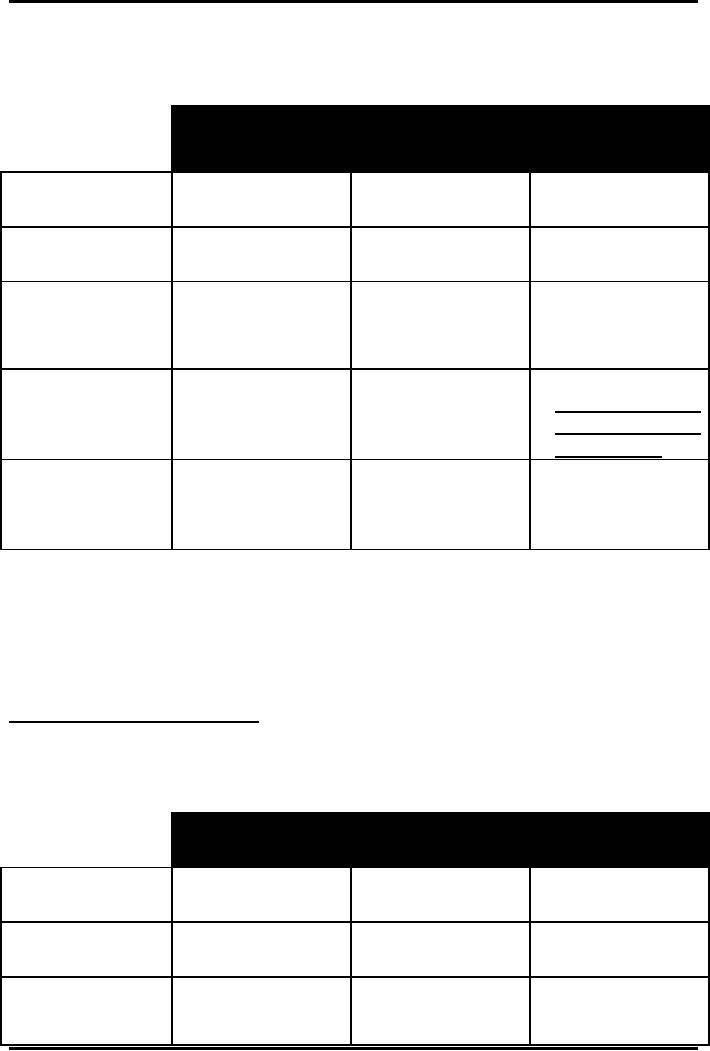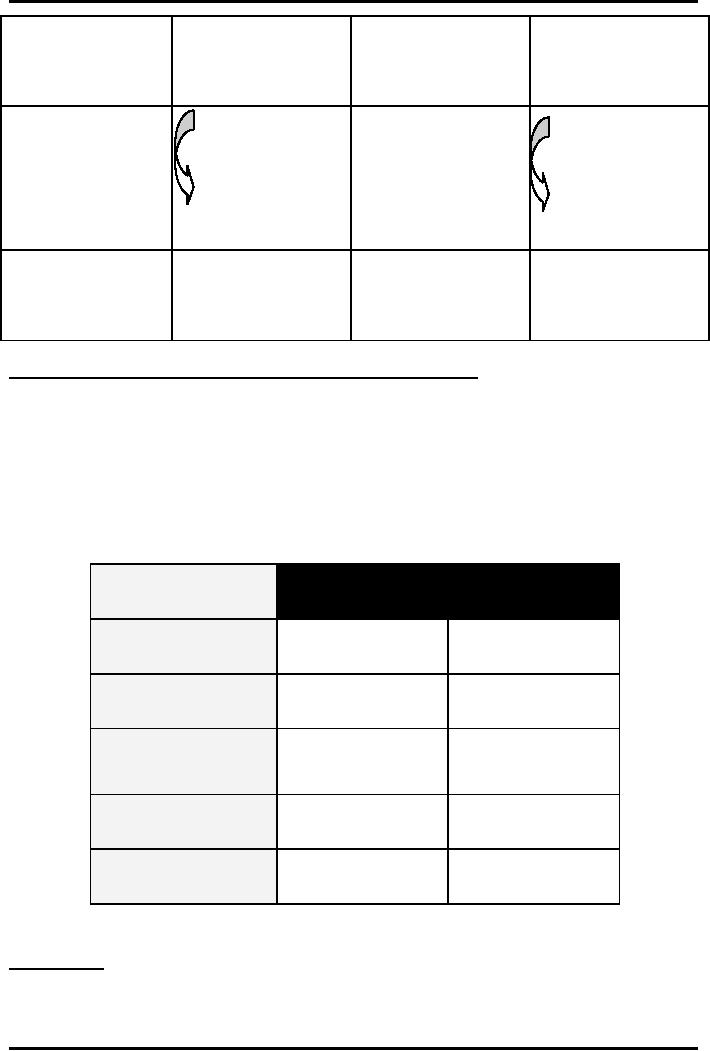 |
PROVISIONS, CONTINGENT LIABILITIES AND CONTINGENT ASSETS |
| << EVENTS AFTER THE BALANCE SHEET DATE |
| ACCOUNTING POLICIES, CHANGES IN ACCOUNTING ESTIMATES AND ERRORS 1 >> |

Advance
Financial Accounting
(FIN-611)
VU
LESSON
# 28
IAS
37 PROVISIONS, CONTINGENT LIABILITIES AND
CONTINGENT
ASSETS
DEFINITIONS:
The
following terms are used in
this Standard with the
meanings specified:
Liability:
A
liability is a present obligation of
the entity arising from past
events, the
settlement
of which is
expected to result in an outflow from the
entity of resources
embodying
economic
benefits. Definition of liability
can be divided into three
parts:
�
Present
obligation
�
Arising
from the past event
�
Probable
outflow of resources in future
Provision:
A
provision is a liability of uncertain
timing or amount. For a provision
following
points
must be kept in mind:
�
Present
obligation
�
Arising
from the past event
�
Probable
outflow of resources in future
�
Amount
can be estimated
reliably.
Provision
is created for two motives:
�
One
to reduce Assets
�
Second
to create a liability against
losses
Provision
that is created for reduction in
assets is of two types:
1.
Provision against receivables
(also known as contra to receivables
Provision
for doubtful debts)
2.
Provision against the expiry
of economic benefits of fixed
assets
(Provision
for depreciation/amortization).
IAS 37
does not talk about the
provisions created to reduce
the carrying amount of
assets.
It only talks about the
provision that is created to recognize a
liability against
probable
losses.
140

Advance
Financial Accounting
(FIN-611)
VU
Obligation
Event:
An
obligating event is an event
that creates a legal or
constructive obligation
that
results
in an entity having no realistic
alternative but to settle that
obligation.
�
Legal
Obligation:
A
legal obligation is an obligation
that derives from:
a) A
contract (through its
explicit or implicit
terms);
b)
Legislation; or
c)
Other operations of law.
�
Constructive
Obligation:
A
constructive obligation is an obligation
that derives from an entity's
actions where:
a) By an
established pattern of past
practice, published policies or a
sufficiently
specific
current statement, the
entity has indicated to
other parties that it
will
accept
certain responsibilities.
b) As a
result, the entity has
created a valid expectation on the
part of those other
parties
that it will discharge those
responsibilities.
Contingent
Liability:
A
contingent liability
is:
a) A
possible obligation that
arises from past events and
whose existence will be
confirmed
only by the occurrence or non-occurrence
of one or more
uncertain
future
events not wholly within the control of
the entity; or
b) A
present obligation that
arises from past events but is not
recognized because:
i.
It is not
probable that an outflow of resources
embodying economic
benefits
will be required to settle the
obligation.
ii.
The
amount of the obligation cannot be
measured with sufficient
reliability;
Contingent
Assets:
A
contingent asset is a possible
asset that arises from past
events and whose
existence
will be
confirmed only by the occurrence or
non-occurrence of one or more
uncertain
future
events not wholly within the control of
the entity.
Treatment
of Liabilities, Accruals &
Provisions:
Liabilities
can be categorized as:
141

Advance
Financial Accounting
(FIN-611)
VU
1.
Certain liability
example
is Creditors against
supplies
2. Virtually
certain liability
example
is Accruals against
expenses
3.
Uncertain liability
example
is Provision against expected
losses
Liabilities
Accruals
Provisions
(certain)
(virtually
certain)
(uncertain)
Present
Present
obligation
Present
obligation
Status
obligation
Arising
from
Past
events
Past
events
Past
events
Outflow
of
resources
Probable
Probable
Probable
embodying
economic
benefits
Uncertain
(However
a
Measurement
of
Certain
Virtually
certain
amount
reliable
estimate
can
be made)
Dr.
Loss
Dr.
Expense
Dr.
Purchases
(Expenses)
Accounting
Cr.
treatment
Cr.
Creditors
Cr.
Provision for
Accrual/Owings
the
Loss
Virtually
certain:
Something
that involve a minor degree of
estimation. An example of such would
be
the
amount payable in Utility Bills. The
expense on the bill is for one month;
however
the
meter is read a couple of
days after the month
including charges for those
extra
days
as well.
Identifying
Contingent Liabilities:
Following
table will help to identify
whether the obligation is a
contingent liability
or
not in accordance with the
definition of IAS
37.
Case
1
Case
2
Case
3
Possible
Present
obligation
Present
obligation
Status
obligation
Arising
from
Past
events
Past
events
Past
events
Will be
confirmed
Outflow
of
resources
upon
the
Probable
Not
probable
embodying
occurrence
or
142

Advance
Financial Accounting
(FIN-611)
VU
economic
benefits
non-occurrence
of
future
events, not
in
the control of
the
entity
a]
Future events
a]
Probability is
not
remote
are
not remote
be b]
Probability is
Cannot
Amount
measured
reliably remote
b]
Future events
are
remote
a]
Disclosed in
a]
Disclosed in
notes
notes
Accounting
Disclosed
in notes
treatment
b] Not
disclosed
b] Not
disclosed in
in
notes
notes
Accounting
Requirements for recognizing Liabilities
and Assets:
Recognizing
liabilities and assets means to record
relevant accounting heads in
the
books
of accounts. IASB frame work and
relevant Accounting Standards
provide
guidelines
for recognizing liabilities and assets at
different stages.
Following
table will explain that which
type of liabilities and assets will be
treated in
what
way.
Stage
Liabilities
Assets
Recognize
Recognize
Certain
Virtually
certain
Recognize
Recognize
(Accruals/Owings)
Uncertain
Do not
recognize
(Probable/Provisio
Recognize
Disclose
only
n)
Do not
recognize
Contingent
Do
nothing
Disclose
only
Remote
Do
nothing
Do
nothing
Do
nothing:
`Do
nothing' means that the
event is to be ignored while preparing
the financial
statements.
Even a disclosure of the
same is not required in the
notes to the
accounts.
143

Advance
Financial Accounting
(FIN-611)
VU
Recognizing
different transactions/events in
Accordance with IAS
37:
Expense/Loss
Measurement
of
Status/Recognize
Accounting
entry
amount
as
(Status)
Certain
Identified
as
Dr.
Expense
(Invoice/supporti
Liability
present
ng
documents
Cr.
Payable
obligation
based)
Virtually
certain
Dr.
Expense
Identified
as
(Invoice/supporti
Accrued
liability
Cr.
present
ng
documents
obligation
Accrual/Owings
based)
Uncertain
(amount
can be
Dr.
Expense
Identified
as
estimated
reliably
(Loss)
present
Provision
liability
with
probable
Cr.
Provision for
obligation
outflow
of
loss
resources)
Uncertain
(amount
can not
be
estimated
Identified
as
reliably
although
Contingent
No
entry.
present
there
is
a
liability
Disclose
only
obligation
probability
of
outflow
of
resources)
Uncertain
(without
any
Identified
as
Contingent
No
entry.
present
probability
of
liability
Disclose
only
obligation
outflow
resources)
Uncertain
(possible
outflow
of
resources are
Unidentified
Contingent
No
entry.
(possible
based
on future
liability
Disclose
only
obligation)
events
not in
control
of the
entity)
Unidentified
No
entry.
No
(remote
Uncertain
No
recognition
disclosure
obligation)
144

Advance
Financial Accounting
(FIN-611)
VU
Accrued
Provision
Contingent
Contingent
Contingent
Creditors
Expense
liability
liability
liability
liability
Liability
Virtually
Certain
Uncertain
Uncertain
Uncertain
Possible
certain
1:
Present
X
obligation
2:
Arising
from
past
events
3:
Probable
outflow
of
resources
X
embodying
economic
benefit
in
future
4:
Reliable
estimation
As
per
As
per
of
the
iouprev
-/
Invoice
X
-
amount
s
X/
received
(can
be
Invoice
measured
reliably)
Losses
against
Expense
warranty
No
entry
No
entry
No
entry
5: Expense/Resources
A/C
Dr.
only
only
only
Accounting
Provision
disclosure disclosure
disclosure
Payable
A/C
Accrual
treatment
for is
required is required is
required
A/C
Warranty
Cr.
Provisions
and Other
Liabilities:
Provisions
can be distinguished from other
liabilities such as trade
payables and
accruals
because there is uncertainty
about the timing or amount of the
future
expenditure
required in settlement. By
contrast:
a)
Trade payables are
liabilities to pay for goods or services
that have been
received
or supplied and have been
invoiced or formally agreed with
the
supplier;
and
145

Advance
Financial Accounting
(FIN-611)
VU
b)
Accruals are liabilities to pay for
goods or services that have
been received or
supplied
but have not been paid,
invoiced or formally agreed with the
supplier,
including
amounts due to employees (for
example amounts relating to
accrued
vacation
pay).
Although it is
sometimes necessary to estimate
the amount or timing of accruals,
the
uncertainty
is generally much less than for
provisions. Accruals are
often reported as
part
of trade and other payables,
whereas provisions are
reported separately.
Relationship
between Provisions and
Contingent Liabilities:
This
Standard distinguishes
between:
a)
Provisions which are recognized as
liabilities (assuming that a
reliable
estimate
can be made) because they
are present obligations and it is
probable
that
an outflow of resources embodying
economic benefits will be required
to
settle
the obligations; and
b)
Contingent liabilities which are
not recognized as liabilities because
they are
either:
i.
Possible
obligations, as it has yet to be
confirmed whether the entity
has
a
present obligation that
could lead to an outflow of
resources
embodying
economic benefits; or
ii.
Present
obligations that do not meet
the recognition criteria in
this
Standard
(because either it is not probable
that an outflow of resources
embodying
economic benefits will be required to
settle the obligation,
or
a
sufficiently reliable estimate of
the amount of the obligation
cannot be
made).
RECOGNITION:
Provisions:
A
provision shall be recognized
when:
a) An
entity has a present
obligation (legal or constructive) as a
result of a past
event;
b) It is
probable that an outflow of resources
embodying economic benefits will
be
required
to settle the obligation;
and
c) A
reliable estimate can be
made of the amount of the
obligation.
If
these conditions are not
met, no provision shall be
recognized.
Present
Obligation:
In
rare cases it is not clear
whether there is a present
obligation. In these cases, a
past
event
is deemed to give rise to a
present obligation if,
taking account of all
available
146

Advance
Financial Accounting
(FIN-611)
VU
evidence,
it is more likely than not,
that a present obligation
exists at the balance
sheet
date.
In
almost all cases it will be clear
whether a past event has
given rise to a
present
obligation.
In rare cases, for example in a law
suit, it may be disputed either
whether
certain
events have occurred or
whether those events result
in a present obligation. In
such
a case, an entity determines whether a
present obligation exists at
the balance
sheet
date by taking into account of all
available evidence, including for
example, the
opinion
of experts. The evidence
considered includes any additional
evidence
provided
by events after the balance
sheet date. On the basis of
such evidence:
a)
Where it is more likely than
not, that a present
obligation exists at the
balance
sheet
date, the entity recognizes
a provision (if the recognition
criteria are met);
and
b)
Where it is more likely that
no present obligation exists at
the balance sheet
date,
the entity discloses
ability, unless the
possibility of an outflow of
resources
embodying
economic benefits is
remote.
Past
Events:
A
past event that leads to a
present obligation is called an
obligating event. For
an
event
to be an obligating event, it is
necessary that the entity
has no realistic
alternative
to settling the obligation
created by the event. This
is the case only:
a)
Where the settlement of the
obligation can be enforced by law;
or
b) In
case of a constructive obligation,
the event creates valid
expectations in other
parties
that the entity will
discharge the
obligation.
Probable
Outflow of Resources Embodying
Economic Benefits:
For
a liability to qualify for recognition
there must be not only a present
obligation but
also
the probability of an outflow of
resources embodying economic
benefits to settle
that
obligation. For the purpose
of this Standard, an outflow of resources
or other
event
is regarded as probable if the
event is more likely than not to
occur i.e. the
probability
that the event will occur is
greater than the probability
that it will not.
Where
it is not probable that a present
obligation exists, an entity
discloses a
contingent
liability, unless the
possibility of an outflow of resources
embodying
economic
benefits is remote.
Reliable
Estimate of the
Obligation:
The
use of estimates is an essential
part of the preparation of
financial statements and
does
not undermine their reliability.
This is especially true in the
case of provisions,
which by
their nature are more
uncertain than most other
balance sheet items.
147

Advance
Financial Accounting
(FIN-611)
VU
Contingent
Liabilities:
An
entity shall not recognize a
contingent liability. A contingent
liability is disclosed
unless
the possibility of an outflow of
resources embodying economic
benefits is
remote.
Contingent
liabilities may develop in a way not
initially expected. Therefore, they
are
assessed
continually to determine whether an
outflow of resources embodying
economic
benefits has become
probable. If it becomes probable
that an outflow of
future
economic benefits will be required for an
item previously dealt with as
a
contingent
liability, a provision is recognized in
the financial statements of
the period
in which
the change in probability
occurs (except in the
extremely rare
circumstances
where
no reliable estimate can be
made).
Example-1:
Extract
from Notes to the
Accounts:
a)
Guarantees issued by banks on
behalf the company;
b)
Claims against the company
were not acknowledged as debt by
the company.
As
the management is confident
that the matter would be
settled in her favor;
consequently
no provision has been made
in the financial statements in
respect
of
the disputed
liabilities.
Contingent
Assets:
An
entity shall not recognize a
contingent asset. Contingent assets
usually arise from
unplanned
or other unexpected events
that give rise to the
possibility of an inflow of
economic
benefits to the entity. An
example is a claim that an
entity is pursuing
through
legal processes, where the
outcome is uncertain.
Contingent
assets are not recognized in financial
statements since this may
result in
the
recognition of income that may
never be realized. However, when
the realization
of
income is virtually certain, then the
related asset is not a contingent
asset and its
recognition
is appropriate.
A
contingent asset is disclosed
where an inflow of economic benefits is
probable.
Example-2:
The
company has filed a suit
against SA Ltd. claming damages
amounting to Rs.
600,000.
The legal advisors of the
company are of the opinion
that the company will
win
the case.
148

Advance
Financial Accounting
(FIN-611)
VU
MEASUREMENT:
Best
Estimate:
The
amount recognized as a provision shall be
the best estimate of the
expenditure
required
to settle the present
obligation at the balance
sheet date.
The
estimates of outcome and financial
effect are determined by the
judgment of the
management
of the entity, supplemented by
experience of similar transactions and
in
some
cases, reports from independent
experts. The evidence
considered includes any
additional
evidence provided by events
after the balance sheet
date.
Example-3:
An
entity sells goods with a warranty under
which customers are covered for
the cost
of
repairs of any manufacturing defects
that become apparent within
the first six
months
after purchase. If minor defects
were detected in all products
sold, repair costs
of
Rs. 1 million would result. If major
defects were detected in all
products sold, repair
costs
of Rs. 4 million would result. The
entities past experience and future
expectations
indicate
that, for the coming year,
75 percent of the goods sold
will have no defects, 20
percent
of the goods sold will have
minor defects and 5 percent of the
goods sold will
have
major defects. In accordance with
3.1.4.2, an entity assesses
the probability of an
outflow for
the warranty obligations as a
whole.
The
expected value of the cost
of repairs is:
(75%
of Nil) + (20% of Rs. 1 m) + (5% of
Rs. 4 m) = Rs.
400,000.
CHALLANGES
IN PROVISION:
Provision
shall be reviewed at each
balance sheet date and
adjusted to reflect
the
current
best estimate. If it is no longer
probable that an outflow of
resources
embodying
economic benefits will be required to
settle the obligation, the
provision
shall
be reversed.
USE
OF PROVISIONS:
A
provision shall be used only for
expenditures for which the provision
was originally
recognized.
Only
expenditures that relate to
the original provision are
set against it.
Setting
expenditures
against a provision that was
originally recognized for another
purpose
would
conceal the impact of two
different events.
Example-8:
A
damage claim of Rs. 15 million for
breach of contract has been
served on the
company.
The company's legal counsel
is of the view that it is probable
that the
damages
will be awarded to plaintiff. So,
the company makes a
provision. In the
next
149

Advance
Financial Accounting
(FIN-611)
VU
year
the case is decided in the
favor of the plaintiff. The
company has to pay Rs.
12
million.
Another suit filed against
the company is also decided
in this year. The
company
has to pay Rs. 2 million in respect of
this case.
Required:
How will you
account for above two
payments?
Solution:
i.
The
first payment of Rs. 12 million
shall be charged to provision and
remaining
provision
should be reversed.
Provision
for claim
15,000,000
Cash
12,000,000
Profit
& Loss (Reversal of
provision)
3,000,000
ii.
The
second payment of Rs. 2 million
shall be charged to P & L
Account
separately.
Damages
Expenses (P & L A/c)
2,000,000
Cash
2,000,000
Application
of the Recognition and
Measurement Rules:
Future
Operating Losses:
a)
Provisions shall not be recognized for
future operating losses.
b)
Future operating losses do not
meet the definition of a
liability and the
general
recognition
criteria set out for
provisions.
c) An
expectation of future operating losses is
an indication that certain assets
of
the
operation may be impaird. An entity
tests these assets for impairment
under
IAS-36
Impairment of Assets.
Onerous
Contracts:
If an
entity has a contract that
is onerous, the present
obligation under the
contract
shall
be recognized and measured as a
provision.
150
Table of Contents:
- ACCOUNTING FOR INCOMPLETE RECORDS
- PRACTICING ACCOUNTING FOR INCOMPLETE RECORDS
- CONVERSION OF SINGLE ENTRY IN DOUBLE ENTRY ACCOUNTING SYSTEM
- SINGLE ENTRY CALCULATION OF MISSING INFORMATION
- SINGLE ENTRY CALCULATION OF MARKUP AND MARGIN
- ACCOUNTING SYSTEM IN NON-PROFIT ORGANIZATIONS
- NON-PROFIT ORGANIZATIONS
- PREPARATION OF FINANCIAL STATEMENTS OF NON-PROFIT ORGANIZATIONS FROM INCOMPLETE RECORDS
- DEPARTMENTAL ACCOUNTS 1
- DEPARTMENTAL ACCOUNTS 2
- BRANCH ACCOUNTING SYSTEMS
- BRANCH ACCOUNTING
- BRANCH ACCOUNTING - STOCK AND DEBTOR SYSTEM
- STOCK AND DEBTORS SYSTEM
- INDEPENDENT BRANCH
- BRANCH ACCOUNTING 1
- BRANCH ACCOUNTING 2
- ESSENTIALS OF PARTNERSHIP
- Partnership Accounts Changes in partnership firm
- COMPANY ACCOUNTS 1
- COMPANY ACCOUNTS 2
- Problems Solving
- COMPANY ACCOUNTS
- RETURNS ON FINANCIAL SOURCES
- IASB’S FRAMEWORK
- ELEMENTS OF FINANCIAL STATEMENTS
- EVENTS AFTER THE BALANCE SHEET DATE
- PROVISIONS, CONTINGENT LIABILITIES AND CONTINGENT ASSETS
- ACCOUNTING POLICIES, CHANGES IN ACCOUNTING ESTIMATES AND ERRORS 1
- ACCOUNTING POLICIES, CHANGES IN ACCOUNTING ESTIMATES AND ERRORS 2
- BORROWING COST
- EXCESS OF THE CARRYING AMOUNT OF THE QUALIFYING ASSET OVER RECOVERABLE AMOUNT
- EARNINGS PER SHARE
- Earnings per Share
- DILUTED EARNINGS PER SHARE
- GROUP ACCOUNTS
- Pre-acquisition Reserves
- GROUP ACCOUNTS: Minority Interest
- GROUP ACCOUNTS: Inter Company Trading (P to S)
- GROUP ACCOUNTS: Fair Value Adjustments
- GROUP ACCOUNTS: Pre-acquistion Profits, Dividends
- GROUP ACCOUNTS: Profit & Loss
- GROUP ACCOUNTS: Minority Interest, Inter Co.
- GROUP ACCOUNTS: Inter Co. Trading (when there is unrealized profit)
- Comprehensive Workings in Group Accounts Consolidated Balance Sheet